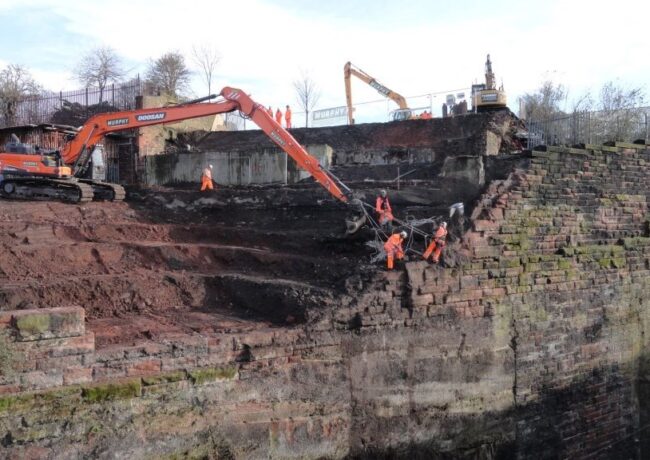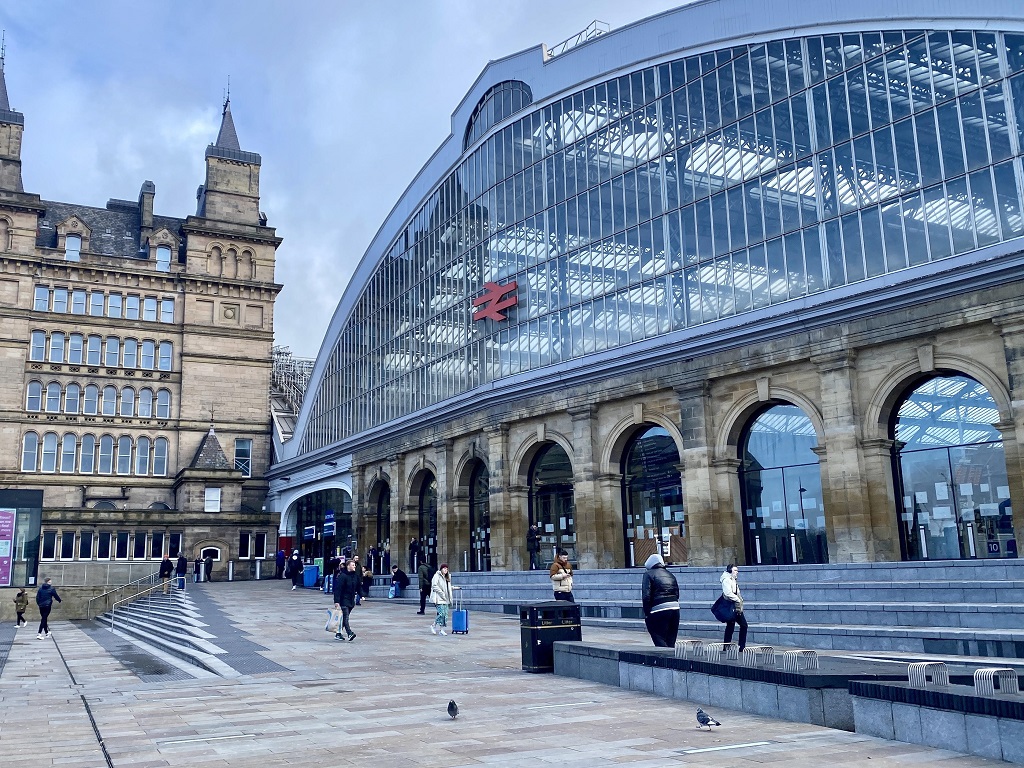No detailed examination of Lime Street collapsed wall since 2014
Network Rail had not carried out an on-site inspection of land above tracks leading into Liverpool Lime Street station since December 2014, according to a report by the Rail Accident Investigation Branch, meaning that excess pressure on a supporting wall which led to its collapse in March was not identified.
Following the incident earlier this year, the RAIB has been investigating the cause, and released its findings in a report on Friday, stating that the collapse was caused by the historic double-stacking of storage containers on the plot. Around 200 tonnes of rubble and soil fell 12 metres onto the tracks, resulting in the closure of the station.
The site had been subject to four detailed examinations since 1997: in March that year; in February 2002; in November 2007; and in December 2014.
Network Rail did undertake two visual investigations in January 2016 and December 2016, but on neither occasion did examiners access the site directly.
As a result, Network Rail was not able to identify any infringement onto its land or any additional pressure on the retaining wall.
Developer Anwar Kassim has a 999-year lease on the plot, which is owned by Liverpool City Council. Kassim was ordered to remove the double-stacked containers from the site in 2012, but single-storey containers remained as they were “immune from enforcement action,” according to Liverpool Council, due to being in situ for more than four years.
The council is now attempting to buy back the land from Kassim via a compulsory purchase order.
At the time of Network Rail’s visit in December 2014, the single-storey containers were present, but any additional pressure on the wall was not identified by the examiner as the area was overgrown. The examiner was also unable to review the previous detailed investigation report from 2007 “due to problems retrieving it at the time”, according to the RAIB.
“A common feature across all the detailed examination reports at this location was insufficient photographs with which to make comparisons between examinations, to identify the changes in land use or the surcharge”, said the RAIB.
The 2014 examination judged the cutting wall to be “in a fair condition”, and recommended overgrown vegetation be removed, and mortar on a section of wall should be repointed. This area was not in the section of wall that collapsed.
Visual examinations by Network Rail in January and December 2016 noted that these recommendations had not been actioned. Network Rail was also unable to confirm whether the repointing of the mortar had been completed.
In both of the 2016 examinations, no staff from Network Rail accessed the land behind the wall which was to collapse, but instead looked at the site using binoculars from track level, and observed the retaining wall from above the cutting, via Smithdown Lane.
The examiner for the January 2016 report stated that no access to the land had been arranged for him.
The RAIB added that it had used open source software including Google Earth and Google Street View to assess changes to the land above the cutting, but Network Rail examiners are not advised to do so.
In its conclusions, the report argued that Network Rail “did not have a suitable risk prioritisation in place to guide the scope and depth of the structures examinations carried out on the retaining wall”.
The collapse had “the potential to derail and/or crush a passing train with the consequent high risk of loss of life and serious injury”, added the report.
It also said Network Rail’s current examination process “does not require the consistent recording of sufficient information to monitor the change in risk to retaining walls”.
The RAIB found that there was a lack of clarity among the examining and reviewing engineers on the requirements expected in examinations, and differences of opinion as to whether the land behind a retaining wall should be accessed during visual examinations, as well as the need to take photographs from the top of a retaining wall.
The investigation also found that there were differences in understanding as to what should be reported as ‘not examined’; in both visual examination reports in 2016 it was recorded that all of the structure had been viewed, when it had not.
“One examiner stated that he had not been briefed on this standard at all,” added the report.
In its recommendations, the RAIB said: “The RAIB has made two recommendations to Network Rail. The first relates to being aware of those of its walls which have a potentially high safety consequence in the event of failure.
“The second is for Network Rail to review its assessment procedures for such walls, the use of open source data to identify changes in land use, and the provision of information on property boundaries to structures examiners.”
Simon French, chief inspector of rail accidents at RAIB, said: “The signs that a dangerous situation was developing had been there for a long time. Network Rail’s examination system did not pick up the significant changes that were taking place behind the wall due to earth moving activities undertaken by the occupier.
“Similar changes in land use can occur anywhere, especially in areas of urban regeneration. Although I recognise that it can be challenging for the railway industry, it is vital that Network Rail carries out regular and effective checks for activities on its boundaries that may endanger the integrity of its structures.
“Changes in technology mean that tools, such as aerial surveys, to improve the way in which such information is gathered and analysed, are now readily available.
“RAIB has made recommendations for the railway industry to put in place systems that will reliably detect threats to high risk structures, and cause prompt and appropriate action to be taken, to avoid a danger to the line.
“I hope that this investigation will result in a significant change to the way that the railway manages risk from its neighbours.”
Network Rail has been contacted for comment.





It wasn’t even subject to “excess pressure”. It was subject to it’s normal live loads, but the masonry was ridiculously unstable due to years or structural neglect and the usual crap attitudes. There’s so many of these conditions up and down the country that who knows where and when the next one will strike.
By Moncleur